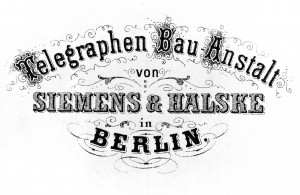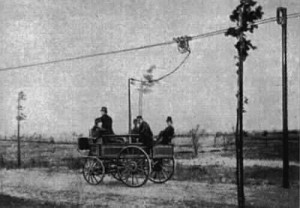Siemens
Short Portrait of Siemens and communicative situation
Fig.: Briefkopf der Firma Siemens & Halske (1847 oder 1856). Source: Wikimedia Commons (gemeinfrei).
Siemens’ company history is a particularly interesting example of the history of corporate public relations in Germany, since the electrical industry in the mid-19th century was a completely new, high-growth and promising industry (see Zipfel 1997a, p. 244, and 1997b, p. 3). This industry branch – similar to the chemical industry – was not simply a modernisation of craft activities and goods that had been familiar to people since the Middle Ages. Therefore, these revolutionary branches of the economy generated new needs for self-portrayal and communication, and at the same time many questions were directed at them from the masses and differentiating sub-publics that developed especially after 1870 (cf. Bentele/Liebert 2005, pp. 234; Liebert 2003, pp. 13-29).
Companies like Siemens prove that there were already extensive activities in the area of business public relations at a very early stage. Regarding Siemens, these activities clearly exceeded methods of attracting and maintaining attention (“publicity”) and thus must be seen far beyond advertising-based methods. The industrialisation caused the necessity to convince the population of the new techniques’ and innovations’ advantages. The company founder Werner von Siemens saw himself confronted with the initial incredulity and fear of the people towards electric current.
The introduction of new, yet unknown goods and services fundamentally changed the way of life of large parts of population to some extent with the result that merely acquisitive activities had to remain unsuccessful unless they included broad information about the new individual and social possibilities.
(Bentele/Liebert 2005, pp. 232)
Fig.: „Elektromote“, der erste Oberleitungsbus (O-Bus) der Welt in Berlin, 1882. Source: Wikimedia Commons (gemeinfrei).
The initially reserved attitude of the population and authorities as well as the necessary of building trust with the own employees required the use of various communicative techniques and instruments which are attributed to corporate communication in the form of both external and internal public relations nowadays.
Between 1847 and 1941, Werner von Siemens, his brother Carl and his sons Wilhelm, Arnold and Carl Friedrich controlled the company’s fortunes. Each of them followed a very specific communication strategy, depending on political, economic and social circumstances, as well as their own style. The history of communication at Siemens has been relatively well re-searched in comparison to the communication history of other companies (especially Zipfel 1997b, see also Kunczik 1997, pp. 231-236)1, but there is a lack of overall descriptions and the last 50 years have not yet been covered in detail.
Siemens AG, headquartered in Berlin and Munich (corporate headquarters), is today one of the world’s largest companies in the electrical and electronics industry with well over 1,500 locations worldwide and a turnover of 85 billion euros. 385000 employees develop and implement products, systems and services in almost 190 regions. The company’s profit after tax will amount to 5.6 billion euros in 2019.2
Annotations
1 As a case study see: Bieler, Denise (2010): Public Relations und Massenkommunikation. Einrichtung von Pressestellen um die Wende des 20. Jahrhunderts. Baden-Baden: Nomos, pp. 207-221. Siemens itself offers historical information at https://new.siemens.com/global/en/company/about/history.html (retrieved December 19, 2019).
2 Online under: https://new.siemens.com/global/en/company/about.html (retrieved December, 19, 2019).



